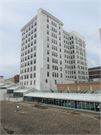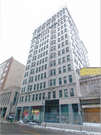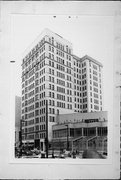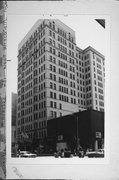Property Record
231 W WISCONSIN AVE
Architecture and History Inventory
| Historic Name: | MAJESTIC BUILDING |
|---|---|
| Other Name: | FIRST BANK BUILDING / Universal Building |
| Contributing: | Yes |
| Reference Number: | 41861 |
| Location (Address): | 231 W WISCONSIN AVE |
|---|---|
| County: | Milwaukee |
| City: | Milwaukee |
| Township/Village: | |
| Unincorporated Community: | |
| Town: | |
| Range: | |
| Direction: | |
| Section: | |
| Quarter Section: | |
| Quarter/Quarter Section: |
| Year Built: | 1907 |
|---|---|
| Additions: | |
| Survey Date: | 1984 |
| Historic Use: | large office building |
| Architectural Style: | Neoclassical/Beaux Arts |
| Structural System: | |
| Wall Material: | Terra Cotta |
| Architect: | Kirchhoff & Rose |
| Other Buildings On Site: | |
| Demolished?: | No |
| Demolished Date: |
| National/State Register Listing Name: | West Side Commercial Historic District |
|---|---|
| National Register Listing Date: | 12/22/2000 |
| National Register Multiple Property Name: |
| Additional Information: | A 'site file' exists for this property. It contains additional information such as correspondence, newspaper clippings, or historical information. It is a public record and may be viewed in person at the Wisconsin Historical Society, Division of Historic Preservation-Public History. Housed the Majestic Theater until at least 1931. Vaudeville acts performed here. Another map code is 19/26 LUQS #397. This building was constructed for the Joseph Schlitz Brewing Co. John Griffiths and Son was the builder. ARCHITECTURAL STATEMENT: Description: The Majestic Building, built in 1907 by the architectural firm of Kirchoff and Rose, is one of Milwaukee's early high-rise office buildings. The building is of steel frame construction and is clad in white glazed terra-cotta and brick. The Wisconsin Avenue facade (85') is divided into three major bays by two smaller projecting bay windows which run continuously from the third to the eleventh floors. The ground floor level is composed of infill store fronts, each different and probably altered from the original design. The second floor has a rusticated surface of white terra-cotta, with flat window heads of voussoir-like block and keystone motif. Floors three through ten have a lightly rusticated surface and double-hung windows with flat heads of voussoir-like block and keystone. A slight cornice separates the tenth and eleventh floors. The eleventh story is similar to floors three through ten, but is surmounted by a heavier cornice. The treatment of the double-hung windows is similar to other floors. Floors twelve and thirteen are treated as a single element, through a bolder articulation of the terra-cotta sheathing, bringing the two floors together. Fairly vigorous cornices separate these two stories from those above and below. The fourteenth (14) floor is similar to the twelfth and thirteenth stories, yet is separated from them by a cornice. An attic story caps the building with a plain band of white glazed brick. Alterations to the fabric have occurred as follows: Permit #593, March 26, 1912 records the construction of a roof penthouse. Permit #16209, July 14, 1921, records the alteration of the floor construction in the Palm Garden, and the erection of a balcony in the same area. Permit #444, January 10, 1922, records the construction of a protecting canopy along the Wisconsin Avenue facade, designed by architect Thomas L. Rose. Permits #14445 (11/15/1934), #10514 (07/17/1935), #1038 (02/10/1936) and #22964 (07/07/36) record the sub-division of the theater space into shops and office space. Permits #32180A and 32181A, April 23, 1953, record the process of testing, reinfocing or replacing the 900 foundation pilings that support the building. Significance: The Majestic Building, constructed for the Schlitz Brewing Company in 1907, is an early Milwaukee example of a multi-use building, containing offices, entertainment facilities, and retail space. The 1.3 million dollar complex offered space for 436 offices, a theater, a Schlitz Palm Garden, and two stores. The theater appears to have been in operation until 1934 at the latest, at which time its conversion to office and retail space bagan. The Palm Garden appears to have been converted to other uses by a $250,000 alteration in 1921. The architect for the Majestic Bulding was the Milwaukee firm of Kirchoff and Rose, whose practice extended between 1897 and 1916. The senior partner was Charles Kirchoff (1856-1916). Thomas Leslie Rose (1868-1935) was born in New York City and initiated his architectural studies in the Chicago office of James J. Egan. In 1897 he entered into partnership with Kirchoff. Other Milwaukee buildings produced by their office include the Second Ward Savings Bank (Currently the Milwaukee County Historical Center and entered on the National Register of Historic Places) and the All Saints Episcopal Cathedral complex. After Kirchoff's death, Rose practiced alone (1916-1920) and later with Roger C. Kirchoff (1920-1934). According to his obituary, Rose acted as personal architect for the Uihlein family of the Schlitz Brewing Company. Either on his own or in collaboration with the yonger Kirchoff, Rose designed the Empire Building, the Palace and Oriental theaters and the Uihlein Candy factory, among other Milwaukee commissions. Rose was a member of the Allied Architects of Milwaukee, who designed the Parklawn public housing during the 1930's. He became a Fellow of the A.I.A. in 1934. Michael Clarke, an African-American attorney, had his law office located here in room 706 in 1969. Clarke was a successful African-American Attorney at a time when racial discrimination was rampant, making him a figure of importance in the Milwaukee community. |
|---|---|
| Bibliographic References: | MILWAUKEE HISTORIC BUILDINGS TOUR: KILBOURNTOWN, CITY OF MILWAUKEE DEPARTMENT OF CITY DEVELOPMENT, 1994. City directories. Gregory, J.G., HISTORY OF MILWAUKEE, vol. IV, 233-244. Young, Mary Ellen, DOWNTOWN MILWAUKEE, (Milwaukee American Revolution Bicentennial Commission), 1978. Wright's Milwaukee (Milwaukee County, WI) City Directory. St. Paul: Wright Directory, 1969. Print. |
| Wisconsin Architecture and History Inventory, State Historic Preservation Office, Wisconsin Historical Society, Madison, Wisconsin |





